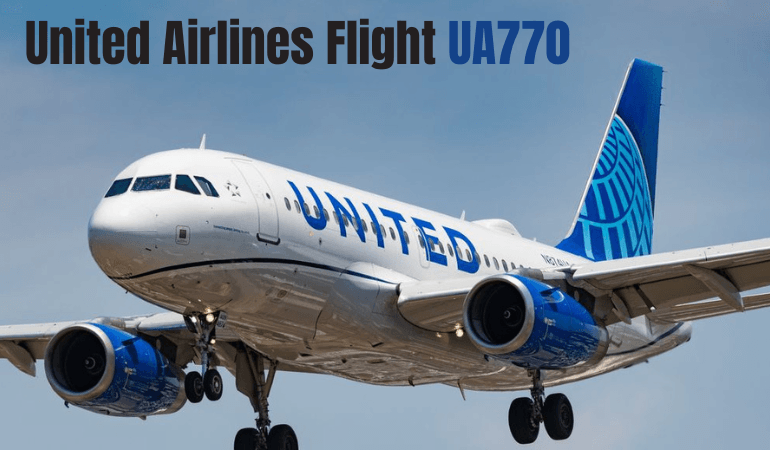Air travel is one of the safest forms of transportation in the world, but sometimes unexpected situations remind us why safety protocols exist. One such moment came when United Airlines Flight UA770 had to make an emergency diversion. What began as a normal long-haul journey quickly turned into a tense but well-managed situation that highlighted the professionalism of pilots, crew, and ground staff.
The Flight and Its Route
United Airlines Flight UA770 was scheduled to operate as a transatlantic service, connecting Europe to the United States. On board were hundreds of passengers, many of them excited for holidays, business meetings, or family reunions. The aircraft—a modern wide-body jet—was cruising smoothly at high altitude when an unexpected technical warning changed the course of the day.
In aviation, even a minor irregularity is treated with the highest level of caution. That mindset is exactly what kept everyone safe on UA770.
The Emergency Alert
At cruising altitude, the cockpit crew received an alert related to the pressurization system. For most travelers, this is not a familiar term, but it is critical: pressurization allows people to breathe comfortably in an aircraft flying above 30,000 feet. Even a small sign that the system might not be functioning perfectly requires immediate action.
Instead of ignoring the warning or hoping it would resolve itself, the pilots made the textbook decision—they declared an emergency. By setting their transponder to “7700,” an international code for emergencies, they alerted air traffic controllers and other aircraft in the region. From that moment, Flight UA770 had top priority in the skies.
Choosing Safety Over Schedule
The aircraft was originally bound for the United States, but pressing on with the journey wasn’t an option. Safety always comes first. The crew quickly evaluated alternatives and decided on an emergency diversion to London Heathrow Airport, one of the world’s busiest and best-equipped aviation hubs.
Why Heathrow?
- It was within reach at the aircraft’s location.
- It had long runways and advanced emergency facilities.
- United Airlines already had staff and support systems in place there.
The decision reflected careful judgment: not the closest airport at any cost, but the safest and most practical option.
The Landing
Passengers reported that the descent felt more controlled than dramatic. Though there was tension in the cabin, the calm announcements from the captain reassured travelers that everything was under control. The crew reminded passengers to remain seated, buckle their belts, and trust the process.
At Heathrow, emergency vehicles stood by along the runway, a routine precaution for incoming diversions. Fortunately, the landing was smooth and uneventful. The aircraft rolled safely to a gate where engineers and medical teams waited just in case.
Passenger Experience
For passengers, the incident was unsettling. Air travel is often routine, and many people never experience diversions, let alone emergencies. Some described feeling a sudden jolt of anxiety when the pilot announced the diversion. Others spoke of relief once the aircraft touched down safely.
What stood out was the professionalism of the crew. Flight attendants walked through the cabin, checking on passengers, answering questions, and offering reassurance. The tone was calm and steady, which helped prevent panic. For many travelers, this incident reinforced their trust in air safety systems rather than shaking it.
After the Diversion
Once safely on the ground, passengers disembarked and were assisted by United Airlines staff. Rebooking arrangements, hotel accommodations, and food vouchers were provided as needed. Engineers immediately began inspecting the aircraft to confirm the cause of the alert and ensure it wouldn’t affect future flights.
The diversion also had ripple effects: connecting flights were delayed, air traffic around Heathrow was adjusted, and the airline’s scheduling team had to rearrange aircraft rotations. These are common challenges whenever a diversion takes place, but airlines are experienced in handling them.
Lessons From UA770
The incident involving Flight UA770 offers several important lessons about air travel and aviation safety:
- Preparedness Works. Pilots and crews train extensively for emergencies. That training showed in how swiftly and professionally the situation was handled.
- Technology Saves Lives. Modern aircraft are full of systems that detect problems early. The pressurization alert may have been precautionary, but it prevented risk by prompting a safe diversion.
- Communication Matters. Clear updates from the cockpit and calm reassurance from the cabin crew helped keep passengers informed and steady.
- Safety Comes First. Airlines may face costs and scheduling headaches when a flight diverts, but protecting passengers is always the priority.
A Reminder for Travelers
For those who fly often, diversions can feel like a disruption. But UA770 is a strong reminder of why they happen: to keep passengers safe. If you ever experience a diversion, it is not a failure of the airline—it is proof that the system works.
Passengers may arrive late, but they arrive safely. And that is the outcome that matters most.
Conclusion
The emergency diversion of United Airlines Flight UA770 could have been a frightening story, but instead it became an example of aviation safety at its best. From the alert in the cockpit to the smooth landing at Heathrow, every layer of the system—from technology to human professionalism—worked exactly as intended.
For the passengers on board, it was an unexpected detour. For the aviation industry, it was another demonstration of how preparation, caution, and commitment to safety ensure that even in emergencies, air travel remains the safest way to cross the globe.


